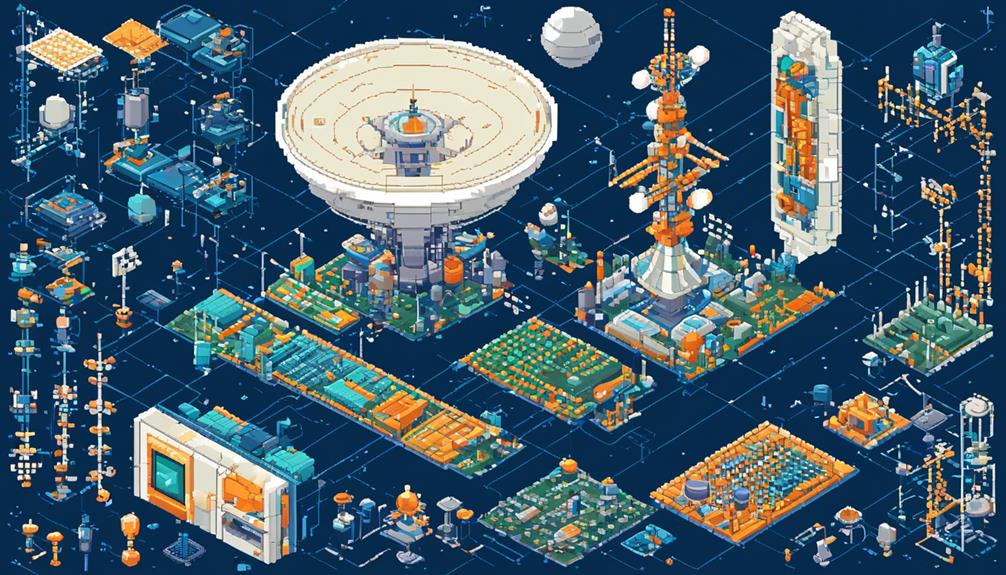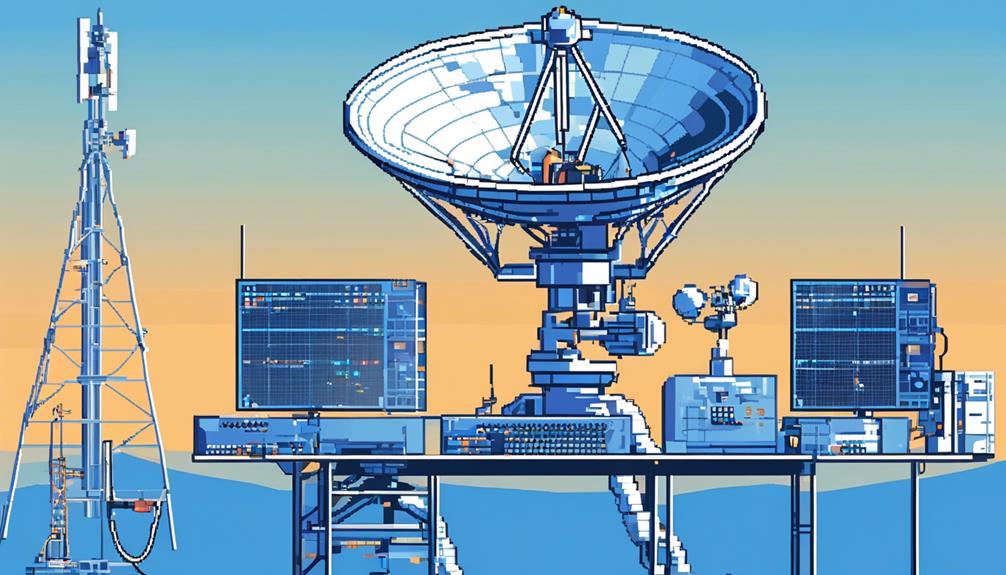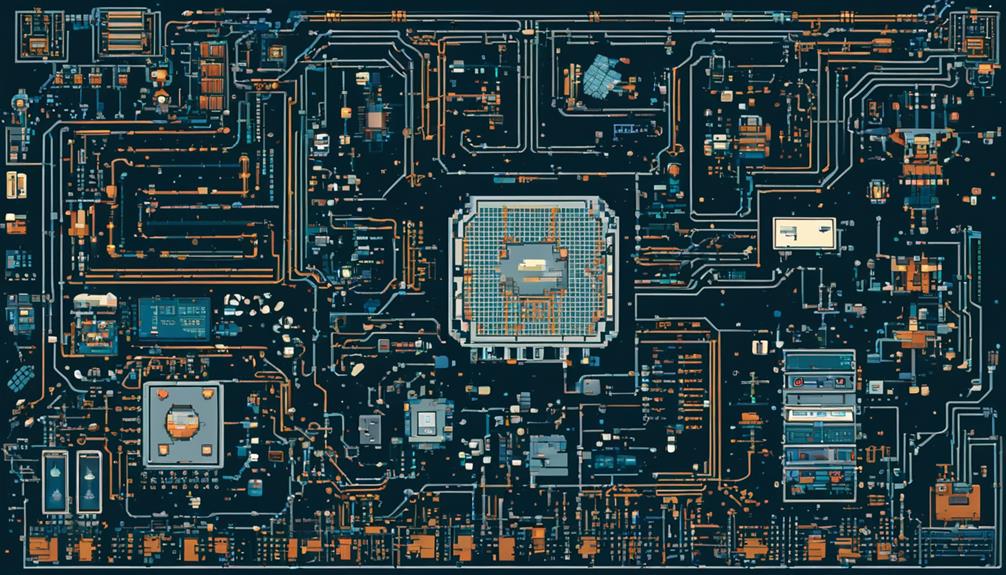Satellite communication has revolutionized the way we connect and communicate across vast distances. Understanding the intricacies of satellite communication hardware is essential for anyone seeking to comprehend this remarkable technology.
From transmitters and receivers to antennas and modems, each component plays a crucial role in ensuring the smooth transmission and reception of signals. But what exactly do these components do? How do they work together to enable seamless communication?
In this discussion, we will delve into the world of satellite communication hardware, exploring its various components, their functions, and the fascinating advancements that continue to shape this field.
So, let us embark on a journey to uncover the inner workings of satellite communication hardware and discover the possibilities it holds for our increasingly interconnected world.
Key Takeaways
- Satellite communication hardware includes components such as transmitters, receivers, signal reception techniques, and antenna designs.
- Modems and amplifiers play a crucial role in converting and boosting signals for transmission in satellite communication systems.
- Multiplexers combine multiple signals into a single composite signal, while frequency converters enable compatibility and communication for different applications.
- Power supplies in satellite communication hardware are designed to withstand space environments, ensure continuous communication, and prioritize efficiency and redundancy.
Transmitters

Transmitters are indispensable components in satellite communication systems, responsible for converting electrical signals into radio waves for transmission to the satellite. These devices play a crucial role in enabling two-way communication between ground stations and satellites, ensuring that data, voice, and other forms of communication can be relayed effectively over long distances.
Satellite communication systems operate within specific frequency bands allocated for satellite communication. Transmitters are designed to operate within these allocated frequency bands, which vary depending on the type of satellite communication system and its intended application. By operating within these designated frequency bands, transmitters ensure interference-free communication and efficient utilization of the available spectrum.
Transmitters in satellite communication systems are often equipped with advanced modulation techniques to maximize the efficiency of signal transmission. These modulation techniques, such as Quadrature Phase Shift Keying (QPSK) or Quadrature Amplitude Modulation (QAM), allow multiple bits of information to be transmitted simultaneously, increasing the data rate and enhancing the overall performance of the communication system.
Transmitters are typically connected to satellite antennas, which are responsible for transmitting the radio waves to the satellite. The antennas focus the transmitted radio waves into a beam that is directed towards the satellite, ensuring efficient utilization of power and maximizing the coverage area.
Receivers
Receivers in satellite communication systems employ various signal reception techniques and antenna design considerations to ensure optimal performance. These techniques include selecting appropriate antenna types, optimizing antenna gain and beamwidth, and implementing filtering and amplification schemes.
Antenna design considerations involve factors such as frequency range, polarization, and physical size constraints.
Signal Reception Techniques
Signal reception techniques, also known as receivers, play a crucial role in demodulating and decoding incoming signals from satellites. These techniques are essential for two-way satellite communication, enabling the ground station to receive signals transmitted from the satellite in orbit. Receivers use various modulation and demodulation techniques to process signals, ensuring that the information carried by the signal is accurately extracted. To provide a visual representation of ideas, the following table highlights the key components of a satellite communication receiver:
| Component | Function |
|---|---|
| Low-Noise Block (LNB) | Amplifies and downconverts satellite signals for satellite TV |
| GPS Receiver | Receives and processes signals from GPS satellites |
| Software-Defined Radio (SDR) | Digitally processes signals for improved signal quality |
Receiver sensitivity and selectivity are crucial factors in achieving optimal signal reception. Sensitivity refers to the ability of the receiver to detect weak signals, while selectivity ensures that the receiver only receives signals within a specific frequency range. These techniques enable reliable communication over long distances using artificial satellites.
Antenna Design Considerations
Antenna design considerations play a critical role in ensuring optimal performance and efficiency of satellite communication receivers. To achieve this, several factors need to be taken into account:
- Antenna size and design: The size and design of the antenna directly impact sensitivity and efficiency. Larger antennas generally provide better reception capabilities.
- Antenna orientation and pointing accuracy: The correct orientation and precise pointing of the antenna are crucial for optimal signal reception. Any deviation can result in weakened or lost signals.
- Frequency bands and polarization: The antenna's frequency bands and polarization must align with the satellite's transmission for effective communication. Proper alignment ensures efficient signal capture.
- Antenna gain and radiation patterns: Antenna gain and radiation patterns determine the ability to capture weak signals and reject interference. Higher gain antennas are capable of capturing signals from greater distances.
Considering these design considerations enables satellite communication systems to establish reliable connections between satellites and Earth stations, ensuring seamless coverage and efficient data transmission.
Whether operating in geostationary orbit, low Earth orbit (LEO), or Medium Earth orbit, antenna design plays a crucial role in optimizing receiver performance.
Antennas

Antennas serve as essential components in satellite communication systems, enabling the transmission and reception of signals between ground stations and satellites. These devices play a fundamental role in establishing communication links in satellite communication. Antennas are used to transmit signals from ground stations to satellites, known as the uplink, and receive signals from satellites to ground stations, known as the downlink.
Different types of antennas are used for various satellite communication applications. Some commonly used antennas include parabolic antennas, phased array antennas, and helical antennas. Each type of antenna has its own advantages and is suitable for specific applications. For example, parabolic antennas are widely used for their high gain and narrow beamwidth, making them suitable for long-range communication. Phased array antennas, on the other hand, offer the advantage of electronically steering the beam, allowing for rapid scanning and tracking of satellites. Helical antennas, with their circular polarization, are often used in applications that require constant communication with moving satellites.
Antennas are designed to operate within specific frequency bands allocated for satellite communication. The design and size of the antenna depend on the desired frequency range and the application requirements. Antennas can be as small as a few centimeters in diameter for applications such as satellite phones, or as large as several meters for high-gain applications like satellite TV reception.
To provide a visual representation, here is a table showcasing the different types of antennas commonly used in satellite communication:
| Antenna Type | Advantages |
|---|---|
| Parabolic | High gain, narrow beamwidth |
| Phased Array | Electronic beam steering |
| Helical | Circular polarization, constant communication with moving satellites |
Modems
Modems, crucial components in satellite communication systems, are devices that modulate and demodulate digital data for transmission over analog communication channels. In the context of satellite communication, modems play a vital role in enabling the exchange of information between ground stations and satellites.
Here are four key points about modems in satellite communication:
- Signal Conversion: Modems convert digital data from a computer or terminal into analog signals suitable for transmission over the satellite link. This conversion process involves modulation, where the digital signals are encoded onto carrier waves, and demodulation, where the analog signals received from the satellite are converted back into digital form.
- Frequency Bands: Modems are designed to operate within specific frequency bands allocated for satellite communication. These frequency bands vary depending on the type of satellite orbit and the intended application. By adhering to these frequency bands, modems ensure efficient and interference-free communication.
- Components and Control Systems: Modems consist of various components, including digital signal processors, amplifiers, and filters, which work together to process and transmit the data. Additionally, control systems within modems regulate the transmission parameters, ensuring optimal performance and reliability.
- Global Coverage: Modems facilitate global coverage by establishing communication links with satellites regardless of their location in the sky. By employing sophisticated tracking mechanisms, modems can maintain a stable connection with satellites, even as they move across the Earth's surface.
Amplifiers

Amplifiers are essential components in satellite communication systems. They are responsible for boosting signal strength and maintaining signal integrity throughout the transmission process. In satellite communications, communication satellites orbiting the Earth in the geostationary orbit act as relays between Earth stations and facilitate various applications such as satellite internet, television broadcasting, and the Global Positioning System (GPS).
Amplifiers play a critical role in ensuring that signals transmitted from communication satellites are strong and clear when received at ground stations. They amplify and change the frequency of signals before relaying them to Earth stations, allowing for effective long-distance communication. Amplifiers are used in both the uplink and downlink stages of satellite communication to enhance the transmission of signals.
Different frequency bands are used for satellite communication, and amplifiers are designed to operate within specific frequency ranges. The choice of amplifier depends on the frequency band being used and the specific requirements of the communication system. High-frequency bands, such as those used in satellite internet or GPS, require specialized amplifiers that can handle the higher frequencies and maintain signal integrity.
Amplifiers not only boost signal strength but also help overcome signal loss that occurs during transmission. They compensate for the loss of signal power due to atmospheric attenuation and other factors, ensuring that the signals transmitted from the satellite are strong enough to be received and decoded accurately at Earth stations.
Multiplexers
In satellite communication systems, multiplexers play a crucial role in optimizing the use of available resources, allowing for the efficient integration and transmission of diverse communication signals over satellite links.
Here are four key points to understand about multiplexers in satellite communication systems:
- Combining Different Signals: Multiplexers are responsible for combining multiple signals into a single composite signal for transmission. This enables the efficient use of satellite bandwidth by allowing multiple signals to share the same channel. Multiplexers can handle various types of data, such as voice, video, and digital data, for simultaneous transmission.
- Integration of Communication Signals: Multiplexers are the main components that enable the integration of different communication signals. They ensure that signals from various sources, such as different communication services or global systems, can be combined and transmitted over satellite links.
- Frequency Band Allocation: Multiplexers also play a vital role in frequency band allocation. They help in assigning specific frequency bands to different signals, ensuring that they do not interfere with each other. This is particularly important in satellite communication systems where multiple frequency bands are used for different purposes.
- Supporting Different Satellite Orbits: Multiplexers are designed to support different satellite orbits, including GEO (Geostationary Earth Orbit) and LEO (Low Earth Orbit) satellites. They are capable of handling the unique requirements of each orbit and ensuring efficient signal transmission regardless of the satellite's position.
Frequency Converters

Frequency converters are essential components in satellite communication systems that convert the frequency of signals to enable seamless communication between ground stations and satellites. These devices play a crucial role in ensuring that signals transmitted from ground stations are compatible with the frequencies used by satellites in orbit.
Satellite communication systems operate in specific frequency bands, which vary depending on the type of satellite and the intended application. Geostationary satellites, for example, operate in the C, Ku, and Ka frequency bands. Frequency converters are used to change the frequency of uplink and downlink signals to match the frequency bands used by these satellites. This allows for efficient and reliable communication between the ground station and the satellite network.
The frequency of signals transmitted by satellites is determined by factors such as the satellite's orbital period and the specific application it serves. For example, satellites used for search and rescue operations typically transmit signals in the L-band frequency range, which provides good coverage and penetration through various weather conditions. Frequency converters are responsible for converting these signals to the appropriate frequency for transmission.
There are two types of satellites in terms of their communication capabilities: active and passive. Active satellites have their own transmitters and receivers, while passive satellites rely on frequency converters to relay signals between ground stations and other satellites. In both cases, frequency converters are essential for ensuring that the signals are transmitted and received accurately.
Power Supplies
Power supplies in satellite communication hardware play a crucial role in providing the necessary electrical energy to operate various components, ensuring a stable and reliable power source for the communication equipment onboard the satellite.
Here are some key facts about power supplies in satellite communication hardware:
- Designed for Space Environments: Power supplies in satellite communication hardware are specifically designed to withstand the rigors of space environments. They are built to withstand radiation and temperature fluctuations that occur in outer space.
- Continuous Communication: The power supplies used in satellite communication hardware are essential for maintaining continuous communication and operation of satellite systems. Without a reliable power source, the satellite's communication capabilities would be compromised.
- Efficiency and Redundancy: Power supplies in satellite communication hardware are often highly efficient, ensuring that energy is utilized effectively. They also incorporate built-in redundancy for reliability. This redundancy ensures that even if one power supply fails, there are backup systems in place to continue providing power.
- Similarities Across Satellites: While different satellites may operate in different frequency bands and have varying purposes, the power supplies used in satellite communication hardware across different satellites are similar. This standardization allows for easier maintenance and repair of these critical components.
Frequently Asked Questions
What Are the 3 Types of Satellite Communication?
There are three types of satellite communication: Geostationary satellites, Low Earth Orbit (LEO) satellites, and Medium Earth Orbit (MEO) satellites.
Geostationary satellites orbit at the same speed as the Earth's rotation and are positioned at a fixed point above the equator.
LEO satellites orbit closer to Earth, offering reduced latency and requiring larger constellations.
MEO satellites provide low-latency, high-bandwidth connectivity.
Each satellite orbit type has its own advantages and is suited for different communication needs.
What Are the Equipment and Devices Used in Satellite Communication?
Antenna technology, modems, routers, transmitters, and receivers are some of the equipment and devices used in satellite communication. These components play crucial roles in establishing and maintaining communication links between satellites and ground stations.
Antennas receive and transmit signals, allowing for the exchange of information between satellites and ground stations. Modems and routers handle data transmission, ensuring that data is sent and received accurately and efficiently.
Tracking systems are used to ensure accurate positioning of the satellites. These systems help track the satellites' movements and make necessary adjustments to maintain communication links.
Ground stations serve as communication hubs, receiving signals from satellites and transmitting signals back. These stations play a vital role in establishing and maintaining communication with satellites.
Satellite dishes are used to capture signals from satellites. These dishes are designed to receive the signals and transmit them to the ground stations for further processing.
Signal amplifiers, decoders, and encoders are used to enhance the quality of the signals. Amplifiers increase the strength of the signals, while decoders and encoders help in converting and encoding the signals for transmission and reception.
Multiplexers and demultiplexers enable multiple signals to be transmitted simultaneously over a single communication channel. These devices help optimize the use of available bandwidth and improve efficiency in signal transmission.
Power amplifiers and solar panels provide power for the equipment used in satellite communication. Power amplifiers increase the power of the signals, while solar panels generate electricity from sunlight to power the satellite communication system.
What Are the 4 Main Parts of a Satellite?
The four main parts of a satellite are:
- The power system: This component provides the necessary energy to operate the satellite.
- The communication system: This system allows for the transmission and reception of data.
- The command and control system: This system is responsible for controlling and monitoring the satellite's functions.
- The payload: The payload is the equipment or instruments carried by the satellite to perform its specific mission or function.
These satellite components work together to enable satellite communication and other satellite operations.
How Do You Explain Satellite Communication?
Satellite communication is a complex system that enables signal transmission between orbiting satellites and ground stations, providing vital connectivity in remote and unreachable areas. It involves orbital mechanics, antenna technology, data encryption, frequency bands, satellite constellations, link budget, ground station operations, interference mitigation, and satellite network architecture.
The process ensures reliable and efficient communication by optimizing signal strength, managing data capacity, and mitigating interference. This intricate network facilitates various applications like TV and radio broadcasting, Wi-Fi, and GPS, expanding possibilities for connectivity in challenging environments.

